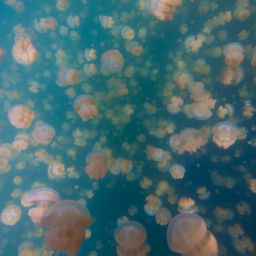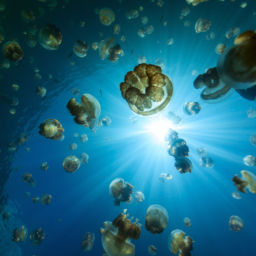The lake stretches still and serene in all directions, its teal green surface undisturbed by tides or currents. It’s like glass, reflecting the intense green of the forest around it and the pure blue of the tropical sky above. The beauty of the scene is remarkable, but only once you slip beneath the surface will you see why this lake is so special. The first surprise is the tang of saltwater seeping around your mouthpiece; the second is the spectacle of millions of jellyfish, an impenetrable mass as far as the eye can see. Their gelatinous bodies surround you, brushing whisperingly against your bare skin, and yet they don’t sting, leaving behind only wonder and astonishment. You take a breath through your snorkel and dive down, twisting to look back at the jellyfish above you, pulsating against the backdrop of the cloudless sky. As you swim through the lake’s waters, the jellyfish part before you and close ranks immediately behind you, a living curtain of golden globes contrasting with the soupy green of the lake itself. It is a psychedelic spectacle that seems otherworldly, and yet this is reality in Palau’s Jellyfish Lake.
[flo_gallery type=”single” name=”jellyfish-lake” id=”8557″ ]
The lake is one of approximately 70 marine lakes on the archipelago’s Rock Islands, between Koror and Peleliu. Once connected to the ocean, changing sea levels left the lake isolated several thousand years ago, creating the perfect ecosystem for a flourishing jellyfish population that has since become distinct from its relatives in neighboring lagoons. There are believed to be over 10 million jellyfish in the lake, comprising two species, the moon jellyfish and the golden jellyfish. Of these, the golden jelly is the most closely related to the spotted species from which they are both thought to have evolved; one of the most significant differences between the two is that over time, the Jellyfish Lake inhabitants have all but lost their sting. This adaptation is the result of a lack of natural predators following the lake’s isolation, and although their sting has not disappeared completely, it is weak enough that snorkelers can explore the lake without sting protection and feel no pain. Golden jellyfish take part in a daily migration across the surface of the lake, in pursuit of the sun as it moves across the sky. Maximum exposure to the sun is vital for this species, which relies on photosynthesizing zooxanthellae living in their tissues to provide them with food symbiotically.
This need for sunlight also explains the tendency of the golden jellyfish to revolve as they propel themselves through the water — this ensures that the sun’s rays reach each part of their bell equally. The jellyfish here must still take evasive action from one predator, the anemones that live in the shadows at the lake’s edges. Consequently, the daily migration of the golden jellyfish from the western edge of the lake to the east stops just short of the shadows before beginning its reverse journey back across the lake, following the sun as it travels towards evening and the western horizon. To observe their daily migration is to observe one of the world’s strangest natural phenomena. Visitors are only allowed to explore on snorkel, however, for two reasons: to protect the jellyfish, which could suffer damage as a result of exposure to divers’ bubbles, and to protect the visitors themselves from the lake’s dangerously anoxic layer, which begins at a depth of 50 feet/15 meters. This oxygen-starved region of the lake contains poisonous levels of hydrogen sulfide, which, while safely out of reach of snorkelers, could be absorbed through a diver’s skin to disastrous effect.
Several Palau tour operators, with the knowledge and expertise to help you safely get the most out of your time there, can organize trips to Jellyfish Lake. They can also organize snorkel-gear rental should you not have your own, as well as the pass required to visit the lake. For more information visit samstours.com.



